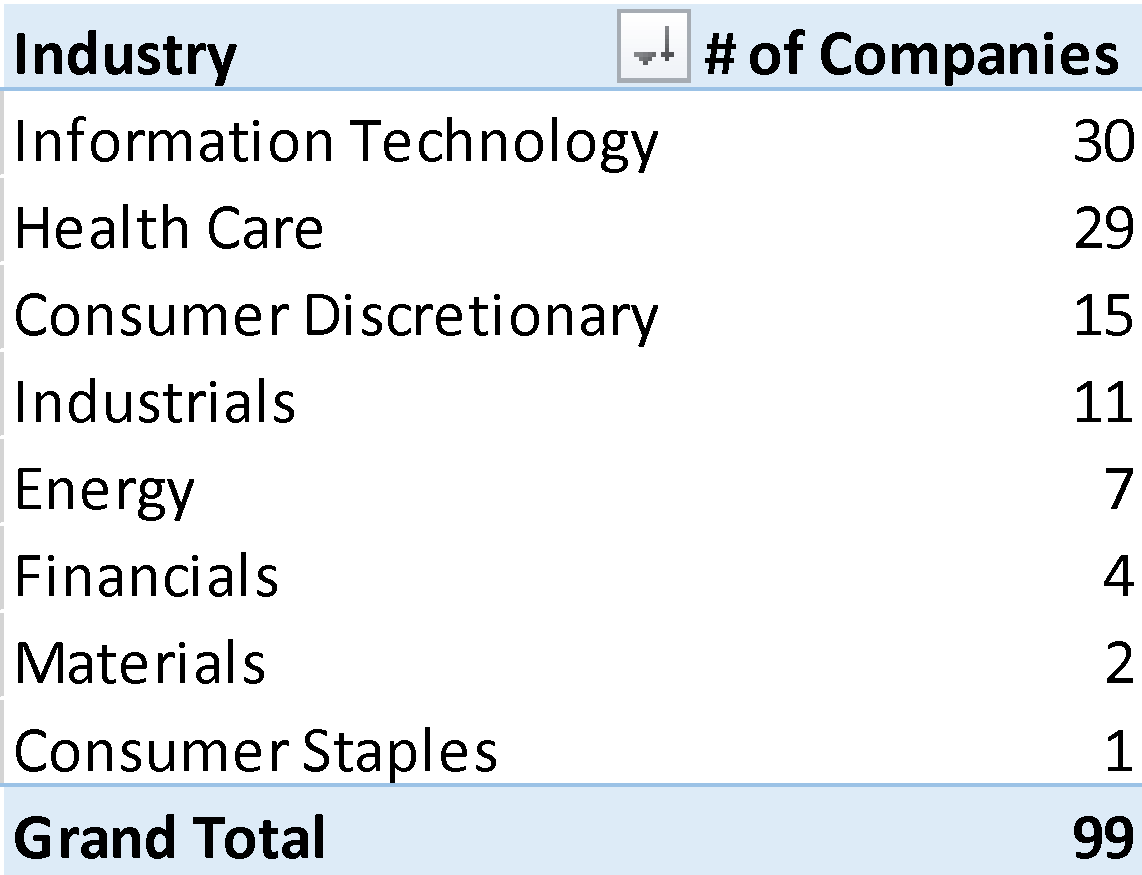Looking across the top performers of 2018, you’d see something that you probably haven’t seen since coming out of The Great Recession: large-cap names that performed exceptionally well. We’re talking names that literally doubled when they were already massive, to begin with. Take Amazon (NASDAQ:AMZN) for example. Starting the year the company was already one of the largest by market capitalization in the world, along with CEO Jeff Bezos being one of the wealthiest people. Fast forward to today, and it’s double the share price. Consider that for a moment - one of the world’s largest companies doubled in value in less than a year!
Not every company was created equal. The S&P 500 isn’t even up double digits for the same time period. The Nasdaq moved up nearly 20% for the year. So what can we learn from the top performers of 2018?
Technology Rules
Outside of the regular smattering of bio and pharma stocks that make up the small caps, one of the things you’d notice about the top companies is that many of them are technology-related. In fact, of the Mega-cap stocks, 2 of the top 5 are IT companies, and you could argue that Amazon and Netflix (NASDAQ:NFLX) should be part of that classification as well.
Consider the following information on Microsoft (NASDAQ:MSFT) and software infrastructure.
You have Microsoft, an $861 billion market-cap company that’s up nearly 30% on the year. Compare that to Intel (NASDAQ:INTC) who’s up a measly 5.33% with semiconductors as a whole up 10.73% YTD. So what gives?
Much of the disparity lies in where and how the company operates. Companies like Intel still rely on consumers to purchase their hardware. When they want to sell more, they have to make more. Microsoft and software infrastructure companies sell software and services that are scalable. Even Amazon derives a significant portion of its revenues from its web services.
However, NVIDIA (NASDAQ:NVDA) sits as an outlier. They provide the GPU cards that are all the rage amongst artificial intelligence programmers and data scientists. But consider where NVIDIA was a handful of years ago. Prior the explosion of AI programming, the company made money, but generally sat in relative obscurity. Unlike the larger companies like Intel, NVIDIA only had a market cap of $9.1 billion in 2013, compared to Intel’s of $128 billion at the time. Consequently, NVIDIA just had more room to grow to its current market cap $170 billion.
The Trend Is Your Friend
Companies like Square (NYSE:SQ) capitalized on the growing trend to cashless transactions and mobile payments. Lululemon Athletica Inc (NASDAQ:LULU) continued advancing activewear that began years ago with the infamous yoga pants. Netflix poured money into original content to provide users with a custom selection of entertainment that met an individual’s particular needs. Each of these companies sits at the top of their game in terms of being the best at both exploiting and monetizing their sector trends.
Even storied companies like the World Wrestling Entertainment Inc (NYSE:WWE) capitalized on the growing trends. The company’s stock jumped over 300% this year, in part from starting at a significant discount, but mainly because they expanded their audience by inking lucrative deals and broadening their efforts to bring their content to a wider audience. While the shows had once been relegated to off networks like USA, don’t be surprised if you begin to see the programming on Fox soon.
When you look at the top 100 return companies in the mid-cap space, you see the same themes.
Unlike with the time after the recession, when financials, materials, and industrials dominated the lists, you see more in the IT, Health Care and Consumer Discretionary. All these signs point to an economy that is chugging along quite nicely.
But Not Everything Is On The Up And Up
When some areas of the market that would normally be leading the way aren’t, you have to question the strength of the rally. Here are a few returns to consider YTD returns:
- iShares Russell 2000 (NYSE:IWM) – 12.59%
- Financial Select Sector SPDR (NYSE:XLF) – 2.42%
- iShares Transportation Average (NYSE:IYT) -7.54%
Any Dow theorist would point out that solid rallies are built on the financials and the transports. Increases in small caps would indicate business investment. Other than the IWM which is a touch ahead of the S&P, the transports have underperformed, and the financials have been woefully stagnant.
What’s odd is to consider this in the context of who the leaders are. Amazon, who dominates the small shipping industry, is growing and shipping at a larger rate than ever. However, the overall transportation environment has been plagued by a labor shortage, along with input costs that have slowly risen throughout the year. In fact, the tax break that the administration and Congress pushed through has mostly been offset by higher costs in basic items like gas and food during the past year.
By far the most perplexing is the underperformance of the financials. Given that we are in a rising interest rate environment, and home sales are strong, it would stand to reason that the banks and financial institutions would benefit. Yet, you still have institutions like Bank of America (NYSE:BAC) that is barely putting up single digit YOY revenue growth, and in some cases seeing negative revenue growth. Of course, there is a multitude of reasons why financials wouldn’t be performing well, but it stands to reason that the current environment should be pretty favorable.
Where Are We Going?
In all likelihood, we won’t see Amazon that just hit $1 trillion in market capitalization double in the next 12 months. What the broad picture painted above should illustrate is that the price appreciation the market is built on relies heavily on growth. It’s by no means the astronomic valuations of the dot.com bubble. However, we see three likely outcomes in the near future that although independently aren’t expected to happen, taken together, there is a good chance one will come to fruition.
1. The trade kerfuffle turns into a war – Yes, it has been talked about at length that in the trade war the other countries facing the US have more to lose. However, don’t try to put limits on human stubbornness and stupidity because you will always be amazed. Regardless of how the trade conflicts resolve themselves, industries have already changed the way they do business, in many cases permanently.
2. Technology takes longer to scale – While the advances in AI and the IoT have been nothing short of astounding in the past handful of years, we’re also still very far away from really taking advantage of these opportunities. Investments in areas like quantum computing aim to take us to that next level, but we’re at a stage similar to where we were with computers in the 1950s and 1960s. Things could take longer to happen than people realize, and that means the growth may not materialize.
3. The free funds come to an end – As the federal reserve in the US and around the globe start to scale back from quantitative easing and raise interest rates, a lot of the debt companies used to fund investments and dividends will start to become more expensive. It’s more than likely that we’ll see some that overleveraged themselves in a bit of a pickle. The higher borrowing costs will probably put a damper on the current growth rate.



